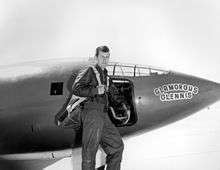Test pilot

.jpg)

A test pilot is an aviator who flies new and modified aircraft in specific maneuvers, known as flight test techniques[2] or FTTs, allowing the results to be measured and the design to be evaluated.
In the 1950s, test pilots were being killed at the rate of about one a week, but the risks have shrunk to a fraction of that, thanks to the maturation of aircraft technology, better ground-testing and simulation of aircraft performance, fly by wire technology and lately, the use of unmanned aerial vehicles to test experimental aircraft features. Still, piloting experimental aircraft remains more dangerous than most other types of flying.
Qualifications
A test pilot must be able to:
- Understand a test plan;
- Stick to a test plan, flying a plane in a highly specific way;
- Carefully document the results of each test;
- Have an excellent feel for the aircraft, and sense exactly how it is behaving oddly if it is doing so;
- Solve problems quickly if anything goes wrong with the aircraft during a test;
- Cope with many different things going wrong at once.
- Effectively communicate flight test observations to engineers and relate engineering results to the pilot community, thus bridging the gap between those who design and build aircraft with those who employ the aircraft to accomplish a mission.
Test pilots must have an excellent knowledge of aeronautical engineering, in order to understand how and why planes are tested. They must be above-average pilots with excellent analytical skills and the ability to fly accurately whilst following a flight plan.
Test pilots can be experimental and engineering test pilots (investigating the characteristics of new types of aircraft during development) or production test pilots (the more mundane role of confirming the characteristics of new aircraft as they come off the production line); many test pilots would perform both roles during their careers. Modern test pilots often receive formal training from highly-selective military test pilot schools, although other test pilots receive training and experience from civilian institutions and/or manufacturers' test pilot development programs.
History
Test flying as a systematic activity started during the First World War, at the Royal Aircraft Establishment (RAE) in the United Kingdom. An "Experimental Flight" was formed at the Central Flying School. During the 1920s, test flying was further developed by the RAE in the UK, and by the National Advisory Committee for Aeronautics (NACA) in the United States. In the 1950s, NACA was transformed into the National Aeronautics and Space Administration, or NASA. During these years, as work was done into aircraft stability and handling qualities, test flying evolved towards a more qualitative scientific profession.
The world's oldest test pilot school is what is now called the Empire Test Pilots' School (motto "Learn to Test - Test to Learn"), at RAF Boscombe Down in the UK. In America, the United States Air Force Test Pilot School is located at Edwards Air Force Base, the United States Naval Test Pilot School is located at Naval Air Station Patuxent River, Maryland and EPNER (Ecole du Personnel Navigant d'Essai et de Reception - "School for flight test and acceptance personnel"), the French test pilot school, is located in Istres, France. The only civilian school in the United States is the National Test Pilot School, a not-for-profit educational institute located in Mojave, California.
Notable test pilots
- Bert Acosta
- Michael T. Alsbury
- Scott D. Anderson
- Neil Armstrong
- Roland Beamont
- Bill Bedford
- Charles F. Bolden, Jr.
- Eric "Winkle" Brown
- Albert Scott Crossfield
- John Cunningham
- Geoffrey de Havilland, Jr.
- John Derry
- Heini Dittmar
- Neville Duke
- Boone Guyton
- Chris Hadfield
- Harry Hawker
- Hedley Hazelden
- Bob Hoover
- Howard Hughes
- Bill Humble
- "Tex" Johnston
- Robert Henry Lawrence, Jr.
- Léon Lemartin
- Tony LeVier
- Mike Melvill
- John Lankester Parker
- Timothy Peake
- Alexey Perelet
- Marina Popovich
- John Cyril Porte
- Jeffrey Quill
- Hanna Reitsch
- Ewald Rohlfs
- Gerry Sayer
- Mutt Summers
- Richard G. Thomas
- Brian Trubshaw
- Andre Turcat
- Joseph John "Tym" Tymczyszyn
- Joseph A. Walker
- Erich Warsitz
- Rakesh Sharma
- George Welch
- Fritz Wendel
- Chuck Yeager
- Janusz Żurakowski
See also
- Test Pilot School, a list of schools
- The Right Stuff by Tom Wolfe
- List of Russian test pilots
References
- ↑ Léon Lemartin (Ai. 1899)
- ↑ Stinton, Darrol. Flying Qualities and Flight Testing of the Airplane. American Institute of Aeronautics and Astronautics, Inc., 1996, p. 265
- Hallion, Richard P.Test Pilots: Frontiersmen of Flight. Washington, DC: Smithsonian Press, 1988. ISBN 978-0874745498
- Warsitz, Lutz: THE FIRST JET PILOT - The Story of German Test Pilot Erich Warsitz, Pen and Sword Books Ltd., England, 2009, ISBN 978-1-84415-818-8
External links
| Wikimedia Commons has media related to Test pilots. |
- The Society of Experimental Test Pilots
- Society of Flight Test Engineers
- Empire Test Pilots School, United Kingdom
- National Test Pilot School, Mojave, California
- U.S. Air Force Test Pilot School, Edwards AFB, California
- U.S. Naval Test Pilot School, NAS Patuxent River, Maryland
- EPNER
- Memorial website for test pilots who died in flying accidents in the UK
- Flight list of display and test pilots at 1957 Farnborough air show
- Aerospace Engineering Test Establishment, Canadian Flight Test Centre
- Indian Air Force Test Pilots School, Bangalore
- The Scott Crossfield Foundation
- website on Erich Warsitz (world’s first jet pilot)
- Oficial European test for pilots